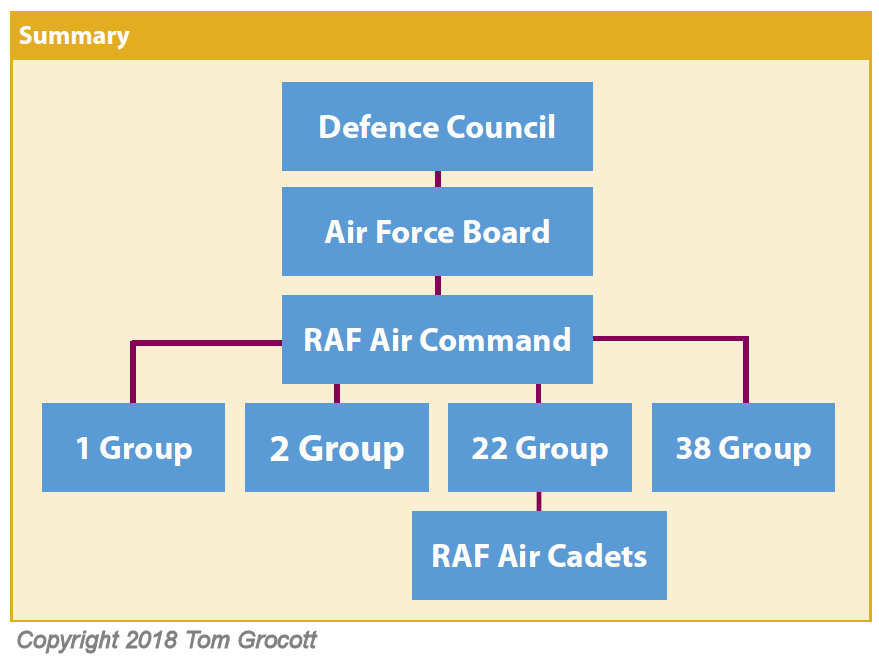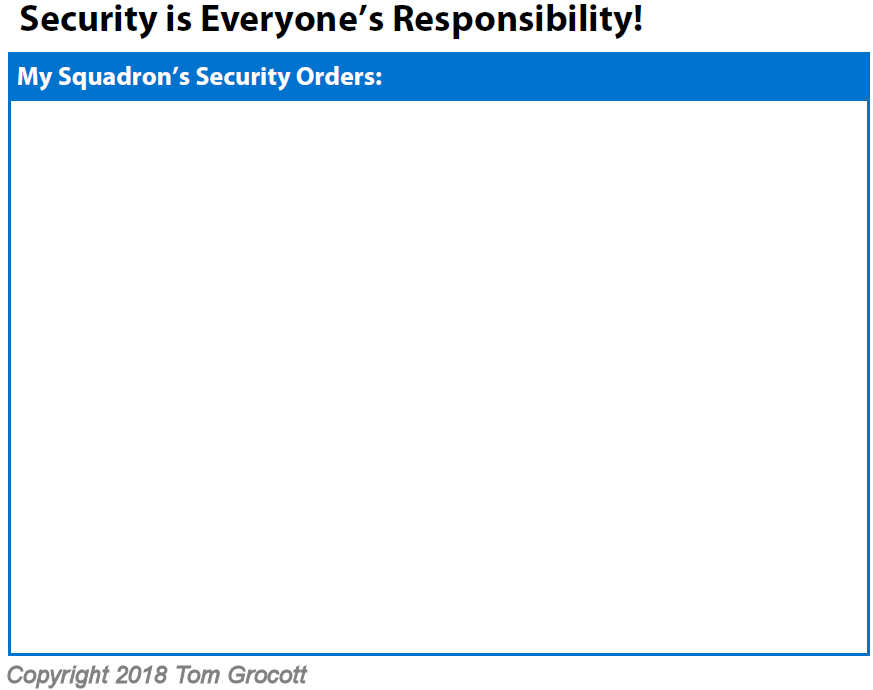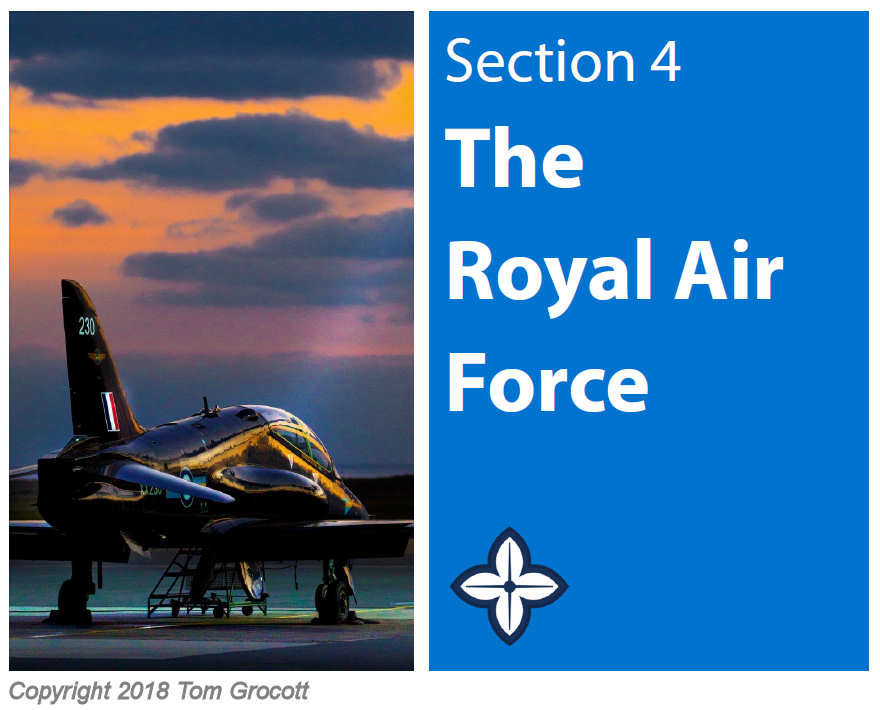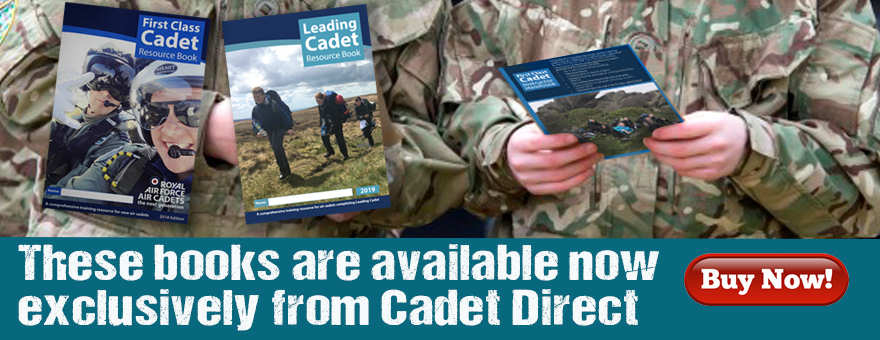The Royal Air Force - Knowledge for Air Cadets
The article below is an extract from the First Class Air Cadet Resource Book.
Please note this information is subject to Copyright 2018 Thomas Grocott. Not for reproduction. Thomas Grocott has asserted his right to be identified as author of this work in accordance with the Copyright, Designs and Patents Act 1988. All rights reserved.Some images in this publication are Crown Copyright and contain public sector information licensed under the Open Government Licence v3.0.
LO1: Know about the history and organisation of the Royal Air Force.
• Identify key developments in the history of the RAF.
• Outline the basic organisational structure of the RAF.
LO2: Understand why security is important.
• Identify why security is important.
• Identify a minimum of 3 threats to security and state the action/s they would take to minimise these threats.
History of the RAF for First Class Air Cadets
In comparison to the Army and the Royal Navy, the Royal Air Force has a relatively short history. Its origins stem from the Royal Flying Corps, which was a joint venture between the Army and the Navy. But how has the RAF developed since its formation?
The Royal Flying Corps
In 1911 the government realised that Britain was falling behind in the ‘race to the skies’, so the Royal Flying Corps was formed in 1912. This was a joint Corps with the Army and Royal Navy sharing control. The Royal Navy broke away from the Royal Flying Corps in June 1914, setting up their own Royal Naval Air Service. The increased use of aircraft for reconnaissance, bombing and air combat spurred on recommendations for the formation of a Royal Air Force. The Royal Air Force (RAF) was formed on the 1st April 1918.
Beginnings of the RAF & World War II
Lord Trenchard was appointed Marshall of the RAF in 1918, based on his work in the RFC. The RAF was given a new badge. The RAFs motto ‘Per Ardua ad Astra’ means ‘Through Adversity to the Stars’. As WWII approached, Bomber, Fighter, Coastal and Training Commands were set up in 1936. The RAF was instrumental in helping to win WWII, which began in 1939. In July 1940 the battle of Britain began. The RAF halted Germany’s plans of invading the UK in September 1940. Despite having less aircraft than Germany, daily flights of Spitfire and Hurricane aircraft prevented Germany from gaining air supremacy; a turning point in the War.
After World War II
The RAF decreased in size from over 1 million personnel in 1945 to around 200,000 by 1950, and less than 100,000 in 1970. During the Cold War against the Soviet Union, the RAF provided the countries nuclear deterrent for a time in the form of the ‘V Bomber’ force, consisting of Valiant, Victor and Vulcan aircraft. There was a constant threat of nuclear attack throughout the Cold War. V Bombers were on standby 24 hours a day throughout the Cold War and could become airborne in 2 1/2 minutes. The RAF played a key part in the Falklands War in 1982. A Vulcan aircraft performed a bombing mission in Argentina, which was an 8000 mile round trip! The RAF have also been involved in conflicts within the Middle East in the 1990s.
The RAF Today
The RAF has decreased in size to around 35,000 personnel, with an increasing reliance on the RAF Reserves. Women can now undertake front line roles in the RAF.
Summary
The RAF was formed in 1918 when the Royal Flying Corps and Royal Navy Air Service joined back together.
• Lord Trenchard played a key part in maintaining the RAF following WW1.
• During WWII the RAF helped prevent German invasion to the UK by achieving air supremacy.

The RAF, like the Army and Royal Navy, is loyal to the crown but controlled by parliament. The Prime Minister and Cabinet hold supreme responsibility for national defence and control the armed forces through the Defence Council. The RAF was reorganised in 2007 into 4 groups. Groups are subheadquarters that operate specialist units. The Air Force Board and RAF Air Command have responsibility for RAF
Groups. From time to time, extra temporary groups may be set up.
1 Group - Air Combat
Responsible for both offensive and defensive roles. It defends British air space and performs ground and air attack
roles. Units which come under 1 Group include fast jet squadrons and the Battle of Britain Memorial Flight.
2 Group - Air Combat Support
2 Group manages the RAF’s support mechanism both on the ground and in the air. All tactical and non tactical air transport, air to air refuelling, the RAF Police and RAF Regiment are part of 2 Group.
22 Group - Training
22 Group is responsible for all aspects of pilot, aircrew and ground crew training. Elementary Flying Training, University Air Squadrons and
the Air Cadets are part of 22 Group. Reformed in 2014. Based at RAF Wittering. Brings together RAF engineering, logistics, communications
and medical operations.
RAF Air Command
RAF Air Command is responsible for the four RAF Groups and all RAF operations. Based at RAF High Wycombe. Commanded by the Chief of Air Staff. Two Deputy Commanders look after the four groups.
Air Force Board
Responsible for the management of the Royal Air Force. Composed of Government Ministers and senior RAF Personnel.
Defence Council
The body legally entrusted with the defence of the United Kingdom and overseas territory. Has control over all British armed forces and is part of the Mininstry of Defence.


Security on RAF bases is paramount – and it is really obvious why! All RAF personnel, including cadets, are likely to know something which others would like to know as well. This information could then be used by terrorists for sabotage or to enable them to launch terrorist attacks. Security is more than just protecting against a direct attack. Sometimes indirect attacks like spying and sabotage can be a threat. The Air Cadets are part of the Royal Air Force, so it is vitally important that everyone takes security seriously. Security is of upmost importance on Ministry of Defence (MoD) property to protect everyone from unnecessary harm. Each site has their own security precautions which you must follow.
Security on MoD Property
Only use authorised entrances and exit points. ALWAYS carry your ID (RAF form 3822). Do not run away from a military security
officer. Comply with instructions from security personnel, they are there to protect you. Don’t wander around on your own, there
are dangers on most bases and you will look suspicious. If someone is acting suspicious – report them! Do not put yourself in danger by
approaching the individual yourself. Don’t touch unattended bags – report them - they may be dangerous. Make sure your belongings are marked
with your name and squadron number. When visiting an MoD site, the staff member accompanying you will advise you of any additional security arrangements.
Security on your Squadron
Every Cadet is responsible for the security of their squadron. If you find anything suspicious on site (like a suspicious package or suspicious
behaviour) it’s your responsibility to report it to a member of staff. You should always be aware of your squadron’s security orders and always
follow them. Every squadron has their own security arrangements. There are several countries and organisations which see the UK as an
enemy and actively gather information about our countries defence. The threat is small for the ATC, however it is important that we remain vigilant
at all times. Security is Everyone’s Responsibility!

Summary
• Security is everyone’s responsibility.
• Always follow the orders of security personnel on a military base.
• Do not run away from security personnel.
Threats to Security
Threats to security on a military base and on the squadron are very unlikely, but if a threat does occur it can come in many forms. What would you do if you discovered a security threat?
Suspicious Packages or Bags
Unknown packages or bags can be a threat as they could have something harmful inside. Do not touch, or pick up and move a suspicious package. Report it to a member of staff straight away.
Unknown Personnel
Unfamiliar people could be a threat. If they are inside the squadron perimeter or lingering around the squadron building they may be suspicious. Report it to a member of staff straight away. Do not approach them, they could be dangerous.
Suspicious Letters/ Messages or Documents
Any misplaced confidential document should be given to a member of staff to prevent it from being accidently released to unauthorised
personnel or members of the public. A letter or online message could contain a threat. Report it to a member of staff immediately.
Summary
• Some threats to security could be:
• A suspicious package or bag left lying around.
• Unknown personnel hanging around the squadron or outside a base.
• A threatening message or confidential document left lying around.




